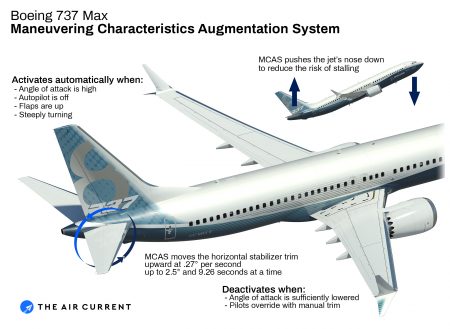November 28, 2018 – More and more it appears that a combination of software and a faulty Angle-of-Attack (AOA) sensor on a brand-new Boeing 737 Max were jointly responsible for the Lion Air Flight 610 crash on October 29, 2018. The Boeing aircraft was equipped with a Maneuvering Characteristics Augmentation System (MCAS). The software combined with the AOA sensor was necessary to help the redesigned aircraft compensate for a much larger engine featured in the 737 Max model. Software combined with sensors would ensure the airplane would not tilt upward at an unsafe rate. The combination of the two would keep the nose at the precise right angle during all aspects of flight to prevent a potential stall.
Was this, in the end, a good design decision? No based on what occurred to this nearly brand new aircraft when it flew on that October day for a mere 11 minutes.
How MCAS is supposed to work: it automatically activates when the AOA sensor indicates the nose of the airplane is at an angle too high, or if the airplane during steep turns, or when flaps up cause the nose to rise. The software under these conditions (see diagram below) executes a command to move the horizontal stabilizer trim upward 0.27 degrees per second up to 2.5 degrees over 9.26-second increments. That forces the aircraft’s nose downward. Pilots can manually override the MCAS but cannot switch it off without switching off the flight computer. This fact in and of itself proved fatal to Flight 610, its crew, and passengers.
For Lion Air Flight 610, the faulty AOA sensor feeding the MCAS made the entire 11-minute flight a battle between software interpreting incorrect data from the AOA sensor and the pilots trying to override the system pushing the nose down.In the end, the pilots lost out with the aircraft slamming nose-down into the Java Sea at a speed of 833 kilometers (518 miles) per hour.
Those 189 who died were victims of Boeing’s redesign of its successful 737 aircraft, all about putting a bigger engine on it and trying to come up with a solution to correct the airplane’s changed aerodynamics. Boeing realized the redesign could lead to potential stalls. MCAS was the answer, an effective software, and hardware safety countermeasure.
But pilots from a number of airlines have accused Boeing of not informing them during training about the MCAS automatic override system. The pilots have further stated that no reference to MCAS appeared in any of the training manuals they were given. It should not be surprising, therefore, that pilots are now questioning Boeing about other undocumented systems and features of the 737 Max.
In checking out the pilots’ claims I visited the 737 Information Site, described as a resource that contains technical, operational, and training notes contributed by 737 pilots and engineers from around the world. In one section of the site, it highlights the key differences between the Max and an older Boeing 737 model. Nowhere in this content is there a reference to MCAS.
Since the crash Boeing has sent out a safety warning with a procedure for cutting off MCAS in the event of an AOA sensor malfunction. A description of what a pilot would experience should the MCAS receive false data has been included so that he or she would know when to disengage the flight computer and manually take over flying the plane.

















